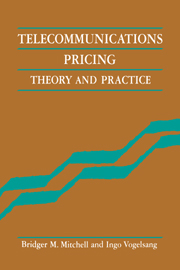Book contents
- Frontmatter
- Contents
- List of figures
- List of tables
- Acknowledgments
- I PRICING AND TELECOMMUNICATIONS
- II RECENT DEVELOPMENTS IN THE NORMATIVE ECONOMIC THEORY OF TARIFFS
- 3 Types of tariffs
- 4 Linear tariffs
- 5 Nonlinear tariffs
- 6 Cost-based tariffs
- III TELEPHONE RATE STRUCTURES IN THE UNITED STATES
- IV SYNTHESIS
- A US telephone price indexes
- Bibliography
- Index
- Selected list of RAND books
6 - Cost-based tariffs
Published online by Cambridge University Press: 28 October 2009
- Frontmatter
- Contents
- List of figures
- List of tables
- Acknowledgments
- I PRICING AND TELECOMMUNICATIONS
- II RECENT DEVELOPMENTS IN THE NORMATIVE ECONOMIC THEORY OF TARIFFS
- 3 Types of tariffs
- 4 Linear tariffs
- 5 Nonlinear tariffs
- 6 Cost-based tariffs
- III TELEPHONE RATE STRUCTURES IN THE UNITED STATES
- IV SYNTHESIS
- A US telephone price indexes
- Bibliography
- Index
- Selected list of RAND books
Summary
The tariffs discussed in Chapters 4 and 5 are the result of (weighted) surplus maximization. Costs enter this maximization procedure as a major argument, along with consumer willingness-to-pay. In contrast, the tariffs to be discussed in the current chapter are derived in a different way. Here we look for tariffs that at least (or at most) cover some notion of costs related to the provision of the various services, to serving various consumer groups, or to serving various consumption patterns (individually and in the aggregate). The yardstick against which costbased tariffs are measured is some concept of costs. The feasibility of such tariffs, rather than their optimality, is the starting point for our analysis. This will not, of course, preclude us from criticizing cost-based tariffs for failing to be optimal.
Subsidy-free pricing
The concepts of subsidy-free prices and sustainable prices are central to the analysis of cost-based tariffs. The rationale for these concepts is twofold. The first rationale links fairness to presumed cost causation, giving precision to the notion that a consumer should pay neither more nor less than the cost that she causes. The second rationale links economic freedom of opportunity to the presumed efficiency of (potential) competition. In its pricing policy an incumbent firm should be put on equal footing with potential entrants, where these entrants could be either competitors or consumers who supply themselves and thus bypass the network.
Alternative concepts of subsidy-free linear prices
There are a number of concepts that relate pricing to cost causation and competition, concepts that are sometimes complex and hard to sort out. To assist the reader we will repeat definitions using different wordings and compare and summarize the concepts later.
- Type
- Chapter
- Information
- Telecommunications PricingTheory and Practice, pp. 118 - 146Publisher: Cambridge University PressPrint publication year: 1991



